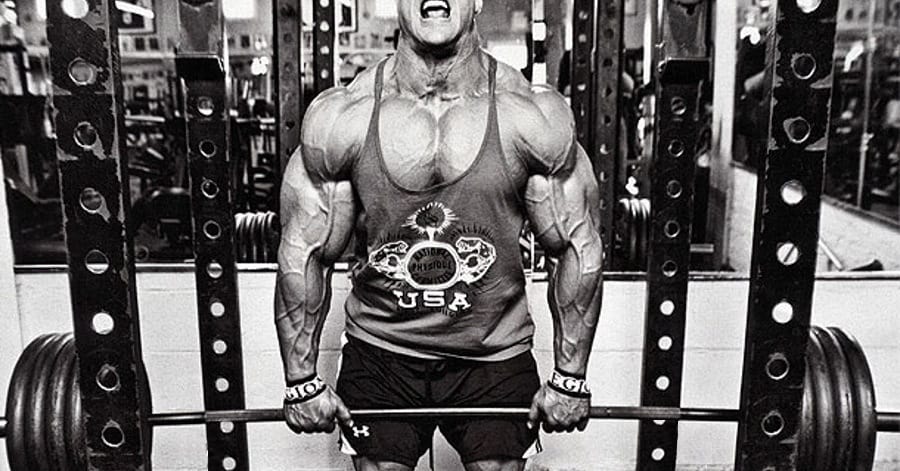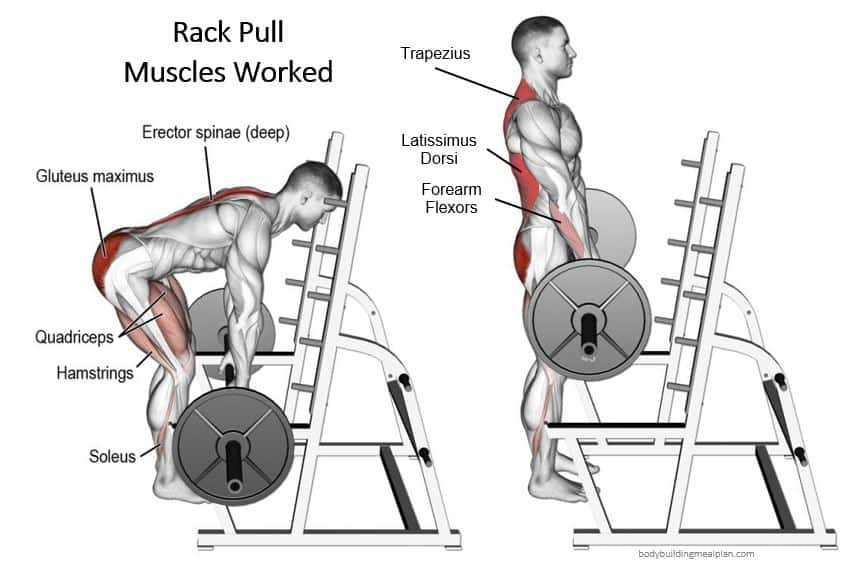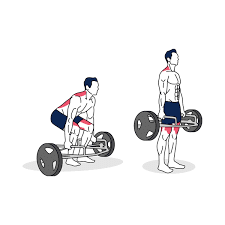
What are rack pulls?
Rack pulls are a resistance exercise used by bodybuilders and strength trainers to develop muscles in the posterior chain. They are a partial movement of a deadlift performed with a loaded barbell on a rack with safety bars.
Rack pulls are often referred to as the baby brother of the deadlift. They are a great alternative to the deadlift if you have mobility issues in your knees or really tight hamstrings but more and more lifters are noticing the benefit of adding them to a regular routine.
You can typically pull a much larger weight with a rack pull making it a great accessory exercise after a deadlift session for adding strength. It also makes a good deadlift warm-up exercise with a light weight.
Which muscles are worked with rack pulls?

The main targets with a rack pull are in the posterior chain. This includes the glutes, lats and traps making it a great compound exercise for the entire back.
It is also great for adding strength to the smaller muscles in the back that typically are not activated with lat pulldowns or rows.
Secondary muscles stimulated are the forearms, quads, hamstrings and calves which all act as stabilisers and assisters for gripping the weight and steadying your stance. The only real difference between a deadlift and a rack pull is that the legs are not activated as much.
You are starting the movement with only a slightly bent leg with a rack pull but with a deadlift, they are responsible for the first part of the movement to get the bar to knee height.
How do I perform rack pulls?
To perform rack pulls you are going to need a squat rack or half rack with pins, a barbell and weight plates.
- Set the safety bars on the rack to just below knee height and rest a barbell bar on them.
- Load the bar with your weight plates. Start light and pyramid up to your working sets.
- Stand in front of the bar, feet shoulder-width apart, and grab the bar with a wide, overhand grip.
- Your back should be straight and your knees bent out over your feet. This is your starting position.
- Take a deep breath, upon exhale, straighten your back and push up with your legs in one movement.
- Push through the heels of your feet and keep your spine straight throughout the movement.
- When you have the bar at waist height, rest for a second or two before lowering the bar back to the rack bars.
If you do not have a rack, you can support the barbell on blocks or weight plates. This does mean that you will need to be more careful when placing the bar down than you would with a rack but it is the next best alternative.
Make sure that you are keeping a straight spine throughout the back so that your glutes and lower back are doing most of the work.
Tips for a better rack pull.
- Don't train too heavy too fast. Rack pulls put a lot of strain on your back muscles and can easily cause injury if not performed correctly. Make sure that you have perfect form and work your way up to heavy weight over some time. Also, make sure you warm up before each session. Using a rowing machine and dynamic stretching is a great way to get the back muscles ready for work. Also, a couple of sets with an empty bar just to get the blood flowing through the quads and hamstrings will be beneficial.
- As mentioned above, keep your spine straight by letting your legs, glutes and lower back take the majority of the strain. If you can not keep your back straight, you are training too heavy.
- Use a belt! Training belts are made for back exercises and using one will give you extra stability when you lift heavy.
- Use wrist straps! Whilst not essential, most people's grip will give up before the back muscles do. Using wrist straps allows you to train to failure of the target muscle and not the failure of your grip. If you don't have wrist straps, consider using chalk.
- Use knee straps! Knee straps provide stability to the knee joint and help avoid any injury. They are not essential but give you extra confidence when lifting heavy.
Alternatives to rack pulls
Hex bar deadlifts.
Hex bar deadlifts are another great alternative to a traditional deadlift if you have mobility or flexibility issues. Hex bars have raised handles so you do not have to lift from as low as you would with a regular bar.
The movement is exactly the same as that of a deadlift. Instead of standing in front f a barbell bar, you are stepping inside a hex bar and gripping from the side.
Hex bars can also be used for rack pulls put as the handles are raised, the safety bars would need to be at such a low height you may as well just lift from the floor.
Block pulls
Block pulls are the same as a rack pull but use dedicated blocks instead of a squat rack safety bar.

A squat rack should always be the preference with this kind of exercise as it allows easier loading and unloading of weight plates and you do not have to worry about the bar missing the blocks when you place the weight down.
If you do not have access to a rack for rack pulls, blocks are the next best alternative. Some lifters will use stacked weight plates instead of blocks. This is not ideal but as long as they provide a sturdy and strong platform for the barbell it is always another option.
Alternatives to rack pulls
Conclusion
We hope that you have found this article useful and now have the answer to the question - What are rack pulls? Check out out FREE workout programs by clicking on the menu at the top of the page.


